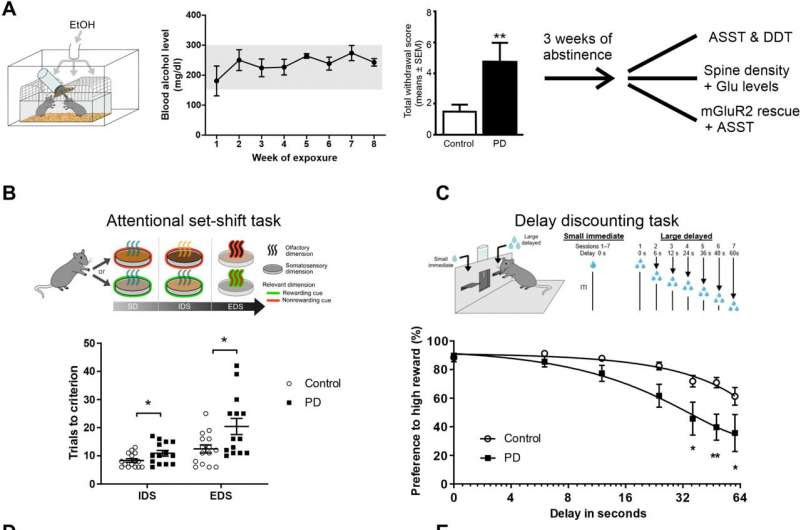by Central Institute of Mental Health (CIMH)

Alcohol dependence: Psilocybin reduces relapsesFig. 1. Alcohol-induced infralimbic mGluR2 deficit leads to impaired ASST performance.(A) Scheme of chronic alcohol-vapor exposure leading to stable blood alcohol concentrations and significantly increased somatic withdrawal scores. After 3 weeks of abstinence, batches of animals were used either for spine density analysis, attentional set-shifting test (ASST), or lentiviral infralimbic mGluR2 rescue. (B) Scheme of ASST, where rats have to make serial discriminative choices based on olfactory or tactile cues/dimensions. ASST performance of alcohol-dependent [postdependent (PD), n = 14, black squares] rats need significantly more trials to criterion in the IDS and EDS subtasks compared to control rats (n = 15, white circles). (C) Scheme of the delay discounting task (DDT). The graph below represents the percentage preference for the high reward against the delay of the high reward in time. Alcohol-dependent rats have a steeper curve (means ± SEM) compared to controls. (D) Schematic representation of genomic location of premature stop codon in P rats (50). (E) Alcohol-naïve Indiana P rats (n = 12, black triangles) do not differ in IDS/EDS tasks compared to Indiana NP rats (n = 12, white triangles). (F) Schematic representation of lentiviral constructs. Lenti-mGluR2 expresses Grm2 and cop green fluorescent protein (copGFP) under control of elongation factor 1-alpha (EF1α) promoter. Lenti-control only expresses copGFP under EF1α control. ENV; Epstein-Barr virus derived vector, cPPT; central polypurine tract, WPRE; Woodchuck posttranscriptional regulatory element. (G) Injection placements are represented by black circles. Injection sites were verified within the infralimbic cortex from +3.2 to +2.2 mm anterior to bregma (85). (H) ASST performance of PD rats injected with either lenti-mGluR2 (n = 16, red squares) or lenti-control (n = 16, black squares) into the infralimbic cortex. In the EDS component of the task, no difference was observed between control and virally infected PD rats. However, in the IDS component, lenti-mGluR2–injected animals overall needed significantly fewer trials to criterion. IDS, intradimensional shift; EDS, extradimensional shift; *P < 0.05, **P < 0.01, and ***P < 0.001. Credit: DOI: 10.1126/sciadv.abh2399 Current research results uncover the unknown potential of psilocybin to restore molecular circuits in the brain and thus contribute to a reduction of relapses in alcohol dependence. This could lead to new therapeutic approaches.
Alcohol dependence is one of the most common neuropsychiatric diseases. In Germany, more than five million people are affected. The consequences are often severe physical and mental suffering and a high mortality rate. The average life expectancyof those affected is reduced by more than 22 years. Despite the severity of the disease, whose chronic course is characterized by frequently recurring relapses into excessive alcoholconsumption and great suffering pressure for those affected, we still know little about the causal mechanisms in the brain.
Cortical mGluR2 deficit as a pathological molecular mechanism of altered behavior in addiction
Mental processes that control behavior, attention and emotions are known as executive functions. In many psychiatric diseases, the ability to control one’s own thoughts and actions and to regulate emotions are disturbed, for example in attention deficit hyperactivity disorder (ADHD), autism, schizophrenia, borderline syndrome and also in addiction.
In a multidisciplinary, international collaboration led by Dr. Marcus Meinhardt, Prof. Dr. Rainer Spanagel and Prof. Dr. Wolfgang Sommer (all at the Central Institute of Mental Health in Mannheim), the molecular mechanism of altered executive functions and increased relapses in alcohol dependence have been investigated. The research focuses on the role of the metabotropic glutamate receptor 2 (mGluR2). In the brain, this receptor works as an antenna for the neurotransmitter-glutamate and regulates its release in various brain areas. In their current work, which has now been published in the journal Science Advances, the research team shows a causal link between a reduced mGluR2 function within the brain region of the prefrontal cortex in alcohol-dependent rodents and an impaired executive control as well as craving for alcohol. mGluR2 activation has thus been identified as a potential therapeutic mechanism in alcohol dependence.
Psilocybin restores the production of mGluR2
Hallucinogenic substances such as psilocybin—the active ingredient in the so-called magic mushrooms—or LSD act on serotonin 2A receptors (5-HT2AR) in the brain. These receptors are present in large numbers in the prefrontal cortex. Previous research has shown that 5-HT2AR and mGluR2 can form a functional complex. This complex has been linked to the mechanismof action of psychedelics, but the molecular functions of this complex in addiction were previously unknown. “We were able to show that psilocybin can restore mGluR2 levels which leads to a reduction in relapses to alcohol,” says Marcus Meinhardt. Thus, this research opens up the possibility of developing new therapeutic approaches that focus on psilocybin as a driver of mGluR2.

Leave a Reply